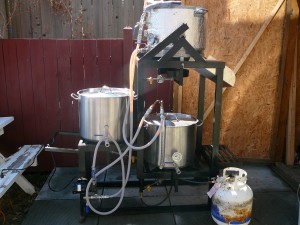I made my first kit beer in years this past weekend. And it got me thinking.
As many readers know, I have been a homebrewer for 26 years, 23 of those as an all-grain brewer. Like most homebrewers of my time, I started with the appalling concentrate in a tin where you are asked to add 20 litres of water and toss in 5 cups of corn sugar. The end result was barely drinkable, but it was cheap. It didn’t take me long to graduate to extract brewing (adding dried or liquid extract and boiling with hops), and after that to the full-meal deal. Over the decades I have upgraded my system and honed my skills where today I can honestly say I make pretty darned good beer most of the time.
Why did I make a kit beer? (Actually I made two.) I blame our new house and the early onset of winter. In our old place, I brewed on the patio in the backyard. I could usually brew into early December and start up again sometime in March. As long as the temperature wasn’t too low, I could brew regardless of snow. Since we moved to our new house a few years ago I brew in the entrance to our unheated garage. A key feature is that my waste water flows down the driveway, into the alley and down the drain. As a result, I am hostage to the thermometer. If the weather is below zero, I can’t responsibly brew. I am not interested in turning my driveway and my neighbours’ alley into a skating rink (maybe I need to be more of an Ayn Rand follower and not care about my neighbours, but it is not in my DNA).
Which means my brew season has been compressed to April to early November. This year I had my final brew session scheduled for late October, but had to scrub the planned day due to work commitments. I re-scheduled for early November, but mother nature intervened in the interim and smacked Edmonton with a cold spell (recent days of just over zero haven’t been quite good enough). Thus I was left with two yeast smack packs (I always brew two batches per brew day) and no prospect of firing up the system until spring.
The only solution was to buy a kit to both utilize the yeast and at least give me some beer over the winter. I visited the Southside Winning Wines Plus and picked up a couple of Paddock Wood ready-to-brew kits, which are full wort volume just needing yeast (although I did mess with one of them to give it a bit of a flavour boost). They are now happily bubbling away in my latest brewery addition, my SS Brewtech stainless steel fermenters.
This very long-winded introduction finally gets me to my main point. Wow, has the homebrew world changed!
When I started, kits were awful train-wrecks of beer. But they were a necessary first step to learn about fermentation and sanitization. I also remember finding all-grain ingredients was a challenge. Local supplies were spotty. My first few years relied on a friend, Soren Jensen, who had access to malt and yeast. Then I was saved by Stephen Cavan at Paddock Wood – then a homebrew supply store rather than a brewery – who did mail order. Even then, choices were relatively thin.
Plus I cannot talk about my homebrewing history without acknowledging the Edmonton Homebrewers’ Guild, who provided a supportive community, offered experienced beer advice and generally made me a better brewer.
Today, quality homebrew stores like Winning Wines Plus carry a wide range of ingredients and supplies, meaning you don’t have drive more than 20 minutes to get world-class product. Homebrewers today can get the very same ingredients the world’s best breweries use, meaning there is nothing stopping us other than our skills as brewers (and the lack of labs and a host of expensive equipment utilized by commercial breweries, but who is counting?).
 But it may be the kit world where things have really changed. It is easier today than ever to make good homebrew without investing the time, money and learning required of all-grain. Instead of stale, oxidized tins of concentrate, budding homebrewers can cart home boxes of high quality wort which they can trust will make decent beer. The more adventurous of them can even hack the kit to personalize the end product.
But it may be the kit world where things have really changed. It is easier today than ever to make good homebrew without investing the time, money and learning required of all-grain. Instead of stale, oxidized tins of concentrate, budding homebrewers can cart home boxes of high quality wort which they can trust will make decent beer. The more adventurous of them can even hack the kit to personalize the end product.
Investment in a couple carboys, some ancillary equipment and less than an hour of time (not including bottling) and you can have beer you won’t be embarrassed to share with your friends. I am amazed. I truly hope these new products lower the bar to entry into homebrewing and thus expand the hobby to a whole new generation of brewers.
Will the kit beer I just pitched be as good as my planned all-grain batches? Likely not. But not because there is something sub-standard about the product. It is about the limited range of wort options and my inability to control the design of the beer to meet my specific desires.
Do these new options make all-grain brewing obsolete? Not even close. In part because of the lack of control I just noted, but also because, frankly, after I had pitched the yeast and cleaned up I didn’t feel very satisfied. I simply hadn’t worked hard enough for it and it felt weird. Many homebrewers will continue to be driven to go from scratch so they can feel the full satisfaction of making a beer with their own hands.
That said, today’s newbie or more casual homebrewer has a whole range of options that simply weren’t available 20 years ago. They, too, can make pretty good beer. And without the time, hassle and complexity of how I do it. Good for them.
Not that I would trade my old school approach for anything. Nothing beats a day of really brewing.


November 30, 2017 at 1:30 PM
All these years later, I’m still proud of contributions to the invention and development of the Ready Brew kits.
November 30, 2017 at 8:23 PM
If your only wastewater is cooling water, try no chill. Basically an extended whirlpool.